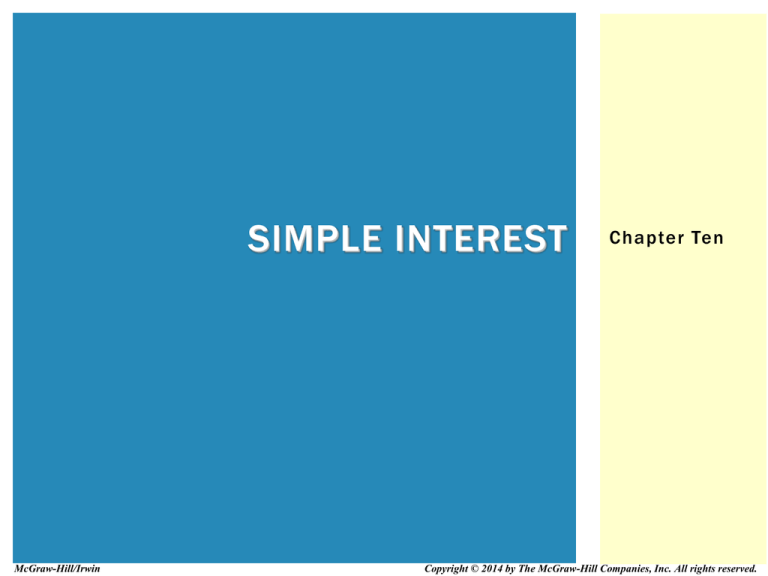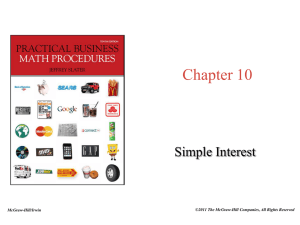
SIMPLE INTEREST
McGraw-Hill/Irwin
Chapter Ten
Copyright © 2014 by The McGraw-Hill Companies, Inc. All rights reserved.
LEARNING UNIT OBJECTIVES
LU 10-1: Calculation of Simple Interest and Maturity Value
1.
Calculate simple interest and maturity value for months and years.
2.
Calculate simple interest and maturity value by (a) exact interest
and (b) ordinary interest.
LU 10-2: Finding Unknown in Simple Interest Formula
1.
Using the interest formula, calculate the unknown when the other
two (principal, rate, or time) are given.
LU 10-3: U.S. Rule -- Making Partial Note Payments before Due Date
1.
List the steps to complete the U.S. Rule.
2.
Complete the proper interest credits under the U.S. Rule.
10-2
MATURITY VALUE
Maturity Value (MV) = Principal (P) + Interest (I)
The amount of the loan
(face value)
Cost of borrowing
money
10-3
SIMPLE INTEREST FORMULA
Simple Interest (I) = Principal (P) x Rate (R) x Time (T)
Stated as a
Percent
Stated in
Years
Example: Jan Carley borrowed $30,000 for office furniture. The loan was for 6
months at an annual interest rate of 8%. What are Jan’s interest and maturity
value?
I = $30,000 x .08 x 6 = $1,200 interest
12
MV = $30,000 + $1,200 = $31,200 maturity value
10-4
SIMPLE INTEREST FORMULA
Simple Interest (I) = Principal (P) x Rate (R) x Time (T)
Stated as a
Percent
Stated in
years
Example: Jan borrowed $30,000. The loan was for 1 year at a rate of 8%.
What is interest and maturity value?
I = $30,000 x .08 x 1 = $2,400 interest
MV = $30,000 + $2,400 = $32,400 maturity value
10-5
TWO METHODS OF CALCULATING SIMPLE
INTEREST AND MATURIT Y VALUE
Method 1: Exact Interest
Used by Federal Reserve banks and the federal government
Exact Interest (365 Days)
Time = Exact number of days
365
10-6
METHOD 1:
EXACT INTEREST
On March 4, Peg Carry borrowed $40,000 at 8%. Interest and principal are due
on July 6.
Exact Interest (365 Days)
I=PxRxT
$40,000 x .08 x 124 = $1,087.12 interest
365
MV = P + I
$40,000 + $1,087.12 = $41,087.12 maturity value
10-7
TWO METHODS OF CALCULATING SIMPLE
INTEREST AND MATURITY VALUE
Method 2 : Ordinary Interest (Banker’s Rule)
Ordinary Interest (360 Days)
Time = Exact number of days
360
10-8
METHOD 2
ORDINARY INTEREST
On March 4, Peg Carry borrowed $40,000 at 8%. Interest and principal are
due on July 6.
Ordinary Interest (360 Days)
I=PxRxT
$40,000 x .08 x 124 = $1,002.22 interest
360
MV = P + I
$40,000 + $1102.22 = $41,102.22 maturity value
10-9
TWO METHODS OF CALCULATING SIMPLE
INTEREST AND MATURITY VALUE
On May 4, Dawn Kristal borrowed $15,000 at 8%.
Interest and principal are due on August 10.
Exact Interest (365 Days)
I=PXRXT
Ordinary Interest (360 Days)
I=PXRXT
$15,000 x .08 x 98 = $322.19 interest
365
$15,000 x .08 x 98 = $326.67 interest
360
MV = P + I
$15,000 + $322.19 = $15,322.19
MV = P + I
$15,000 + $326.67 = $15,326.67
10-10
FINDING UNKNOWN IN SIMPLE
INTEREST FORMULA: PRINCIPAL
Principal = Interest
Rate x Time
Example: Tim Jarvis paid the bank $19.48 interest at 9.5% for 90 days. How
much did Tim borrow using the ordinary interest method?
P =
$19.48
. = $820.21
.095 x (90/360)
.095 times 90 divided by 360. (Do
not round answer.)
Interest (I) = Principal (P) x Rate (R) x Time (T)
Check 19.48 = 820.21 x .095 x 90/360
10-11
FINDING UNKNOWN IN SIMPLE
INTEREST FORMULA: RATE
Rate =
Interest
Principal x Time
Example: Tim Jarvis borrowed $820.21 from a bank. Tim’s interest is $19.48
for 90 days. What rate of interest did Tim pay using the ordinary interest
method?
$19.48
.
R = $820.21 x (90/360) = 9.5%
Interest (I) = Principal (P) x Rate (R) x Time (T)
Check 19.48 = 820.21 x .095 x 90/360
10-12
FINDING UNKNOWN IN SIMPLE
INTEREST FORMULA: TIME
Time (years) =
Interest
Principle x Rate
Example: Tim Jarvis borrowed $820.21 from a bank. Tim’s interest is $19.48 for
90 days. What rate of interest did Tim pay using ordinary interest method?
T =
$19.48
= .25.
$820.21 x .095
.25 x 360 = 90 days
Convert years to days (assume 360 days)
Interest (I) = Principal (P) x Rate (R) x Time (T)
Check 19.48 = 820.21 x .095 x 90/360
10-13
U.S. RULE - MAKING PARTIAL NOTE
PAYMENTS BEFORE DUE DATE
Any partial loan payment first covers any interest that has
built up. The remainder of the partial payment reduces the
loan principal.
Allows the borrower to receive proper interest credits.
10-14
U.S. RULE
(EXAMPLE)
Joe Mill owes $5,000 on an 11%, 90-day note. On day 50, Joe pays $600 on the
note. On day 80, Joe makes an $800 additional payment. Assume a 360-day year.
What is Joe’s adjusted balance after day 50 and after day 80? What is the ending
balance due?
Step 1. Calculate interest on principal from
date of loan to date of first principal
payment.
Step 2. Apply partial payment to interest due.
Subtract remainder of payment from
principal.
$5,000 x .11 x 50 = $76.39
360
$600 -- 76.39 = $523.61
$5,000 – 523.61 = $4,476.39
10-15
U.S. RULE
(EXAMPLE, CONTINUED)
Joe Mill owes $5,000 on an 11%, 90-day note. On day 50, Joe pays $600 on the note.
On day 80, Joe makes an $800 additional payment. Assume a 360-day year. What is
Joe’s adjusted balance after day 50 and after day 80? What is the ending balance due?
Step 3. Calculate interest on adjusted
balance that starts from previous
payment date and goes to new
payment date. Then apply Step 2.
$4,476.39 x .11 x 30 = $41.03
360
$800 -- 41.03 = $758.97
$4,476.39 – 758.97 = $3717.42
Step 4. At maturity, calculate interest from
last partial payment. Add this
interest to adjusted balance.
$3,717.42 x .11 x 10
360
= $11.36
$3,717.42 + $11.36 = $3,728.78
10-16







